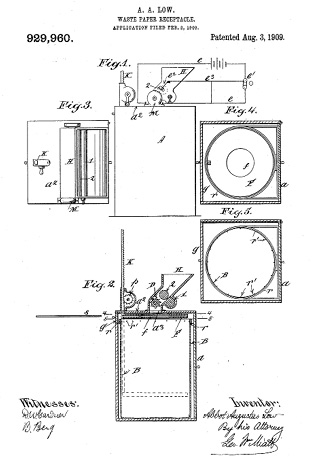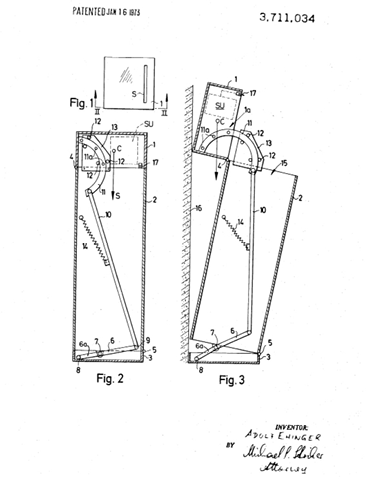22
Analogue Privacy: The Paper Shredder as a Technology for Knowledge Destruction
Sarah Blacker
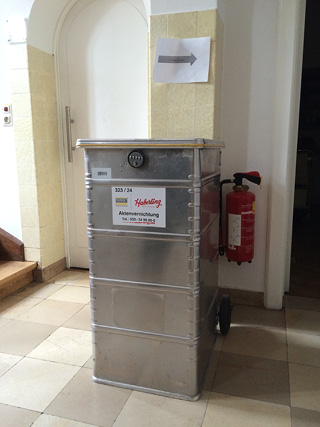
Fig. 22.1 Haberling Sicherheitsbehälter at the Max Planck Institute for the History of Science: a locked container that securely stores documents prior to their being shredded (photo by Sarah Blacker)
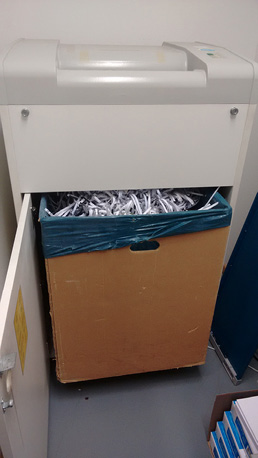
Fig. 22.2 Paper shredder at the Max Planck Institute for the History of Science, with a view of the interior box collecting shredded remnants (photo by Martina Schlünder)
Box name: the paper shredder. Other names: Aktenvernichter (German, meaning ‘file annihilator’). Size and shape: size and shape vary by geographic location and family type. Larger models bred for institutional settings can grow up to 760 x 580 x 1540 mm (see Figure 22.2). Smaller shredders, typically found in closets of apartment-dwelling humans, can measure only 296 x 161 x 297 mm (see Figure 22.3). Appearance: metallic, cold, and sometimes dusty. The metallic box is enlivened – its shredding function superseding its boxness and capacity for storage – when the electrical cord attached to the box is joined with an electrical outlet. Behaviour: regular, machinic, robotic, predictable. Incapable of discrimination. Equal opportunity destroyer. Except in the case of the so-called ‘paper jam’, which indicates the shredder’s capacity for resistance, for overriding its commands, and saving rather than destroying. Could pose a fire hazard if overfilled, thus potentially enacting a form of meta-destruction of its own habitat. Habitat: in hidden places – corners, closets, and beneath desks – unless its use becomes the primary focus (at moments of urgently-required dismantling, erasing, moving, cleaning), in which case the shredder migrates to spaces of increased visibility and prominence. Migration/Distribution: often found in hallways or in closets, the shredder shies away from excessive visibility. The shredder frequently stands next to its distant cousin, the paper recycling box, which stores and redistributes printed material, but, unlike the voracious shredder, does not destroy it. Status: population growth remains robust despite the ‘digital revolution’ that was framed as a threat to the population’s survival in the early 2000s.
Keywords: fragmenting, concealing, secret-keeping, history-erasing, voracious, protective, incriminating, unappeasable, insatiable, compulsive, desirous, waste-producing, destructive, defiant

Fig. 22.3 Hama paper shredder (designed for home use; photo by Sarah Blacker)
To shred: ‘to cut or hack in pieces’ (OED).
Shredder: ‘a machine for reducing documents to small unreadable fragments’ (OED).
Fragment: ‘A detached, isolated, or incomplete part; a part remaining or still preserved when the whole is lost or destroyed’ (OED).
The paper shredder could also be called a fragmentation machine. Within the enclosure of its boxness, the shredder fragments the components of knowledge to the point at which they are no longer legible, no longer circulable, and no longer able to serve as evidence. By producing detachment, isolation, and incompleteness within a body of knowledge, the shredding box reverses the wheels of knowledge production. No longer marching onwards and upwards, knowledge production grinds to a halt as the shredder shifts the direction of production into reverse. The point is no longer accumulation, but the backwards motion of undoing what has already been done, unsaying what has been said, and preventing this knowledge from producing the transformative (and potentially damaging) effects that are expected to follow from its circulation.
Does its form as a box play a deterministic role in shaping the paper shredder’s politics? While the shredding box’s metal teeth render all that passes through them irreversibly illegible, the politics that this function enacts are not mono-dimensional or easily categorisable. Though paper passes through the shredder in one direction only (see Figure 22.4), and with a single epistemological result – destruction – the disappearance enacted can serve wildly different interests. The twin purposes of the paper shredder – to preserve security/privacy and to effect an imagined total form of destruction; to keep, store, save, but also to eliminate – are in fact deeply intertwined. Security can be preserved through the destruction of circulable materials. Security is threatened when circulable materials fall into the wrong hands. The shredder ensures that circulable materials never fall into the wrong hands. But in producing this security, the shredder also introduces the possibility that the printed materials will never fall into any hands at all – including those of the historian and the archive waiting to preserve the knowledge that would otherwise pass into oblivion.1
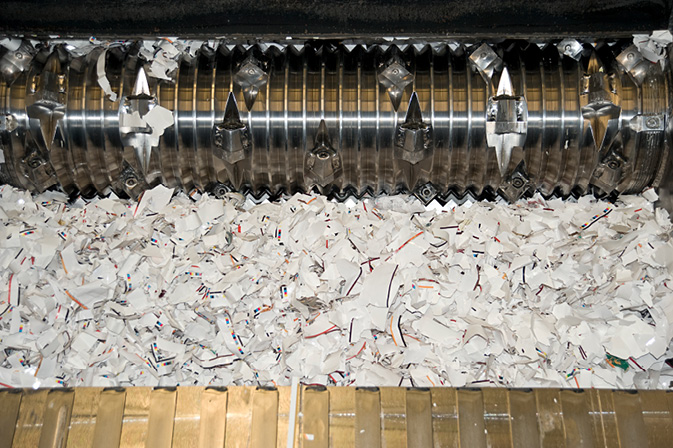
Fig. 22.4 The paper shredder’s metal ‘teeth’, spinning shaft, and paper fragments produced. Friesens Corporation, Altona, Manitoba, Canada, 2011 (photo by Rosemarie and Pat Keough; reprinted with permission from Rosemarie and Pat Keough)
What does it mean for knowledge2 to pass into oblivion? For historians, the absence of archival documents is the stuff of nightmares – without them, how can the roots of today’s norms, institutions, and ways of knowing be understood? Oblivion comes from the Latin oblivio, meaning ‘forgetfulness, state of being forgotten, amnesty’ (OED). Why do we need to ensure access to amnesty or the act of being pardoned as we participate in the production of knowledge? Why do we need to leave open the possibility of forgetfulness? What sorts of roles are played by infrastructures of forgetting (Bowker 2005)? We often think of work around knowledge as a linear, cumulative, and fundamentally productive activity, and a fundamental good in this very productivity, regardless of its lack of moral compass. But knowledge production is always risky. We need methods through which mis-steps can be erased, and, often, methods by which whole bodies of knowledge can disappear in the context of a change in political regime, when such knowledge becomes the enemy of power.
The effectiveness of the paper shredder in destroying knowledge tells us a great deal about the character of the knowledge that can be destroyed. Quality 1: a sense of wholeness (such that fragmentation can be the enemy of knowledge). Quality 2: legibility. Quality 3: corruptibility (the speed and ease with which a document can be altered threatens its robustness as a form of knowledge. While the social and political stabilisation of knowledge enacted by paper technology has always been inconsistent and uneven, digital documents have been understood as essentially volatile and unduly prone to corruption. One of the reasons that the digital is understood as volatile is that digital documents are seen as having skipped over processes of editing and of printing, both of which slow down the production of documents and lend a quality of evidenceness through the sense that the document has been ‘checked’ by multiple sets of eyes, with the result that corruption is less likely to reach the printed page). Quality 4: capacity to be circulated (previously: paper-ness, and now: digitality). The paper shredder, of course, is an analogue technology. Its closest relative in the digital era is the Right to Be Forgotten legislation (see the chapter on Dropbox and the impossibility of digital forgetting by Shih-Pei Chen, in this volume). Concerns surrounding the security of data in the online context have not yet eclipsed those of paper security. The shredder has not become obsolete in the digital era; shredding technology persists in both visual and auditory forms in today’s computer programs, allowing for the virtual ‘shredding’ of documents. Many computer programs mimic the sounds made by paper shredding machines when the computer user deletes a document, and the visual icon denoting the computer’s ‘trash can’ renders this destructive computer function visually legible to the computer user, who is assumed to be familiar with the paper shredder from non-virtual experience of using it.
The inventor of the paper shredder is acknowledged as Abbot Augustus Low, of Horseshoe, New York, who was granted a patent for his ‘waste-paper receptacle’ in 1909 (see Figure 22.5). In his patent application, Low describes his machine as one that provides ‘improved means for disposing of waste paper’ (1909: 1). By ‘improved means’, Low is referring to the machine’s destructive tendencies. Low emphasises the ambivalent value of paper documents, noting that what we think of as the ‘safe-keeping’ of printed materials might not best take place in a filing cabinet, but instead in a box designed to make these documents – and all traces of their existence – disappear. He notes that the ‘waste-paper receptacle’ will be used ‘in offices and other places where not only the collection and storage of waste paper is desirable, but also its cancellation or mutilation in such a manner as to render it unavailable or unintelligible for re-use or for information’ (Low 1909: 1). Low’s box, then, was designed to put dangerous documents to rest once and for all; in limiting printed materials’ circulability and readability, authors and collectives were seeking to avoid accountability for the social and political fallout of these materials. The enthusiasm and energy imbuing the text of Low’s patent application departs significantly from the cold, rational language usually used to describe storage methods in this period. The prospect of destruction can indeed produce levity! Low’s description of the mechanism through which paper is fragmented within the box characterises paper as a sort of menace that must be contained, its powers curtailed. He writes: ‘The invention consists primarily of a receptacle having a cutting or cancelling device interposed between it and a receiving hopper, whereby the papers are disintegrated and rendered useless as such before they enter the body of the receptacle’ (Low 1909: 1). Low goes on to describe the risks one incurs if one does not make the practice of paper shredding as regular as other self-maintenance practices. He warns that printed materials can be appropriated by criminals and used to commit fraud, and, further, that ‘the presence of papers scattered around promiscuously’ in one’s home or office increases the risk of fire (Low 1909: 1–2). These risks can be managed by the regular use of Low’s ‘waste-paper receptacle’, whose name does not yet betray its destructive tendencies, instead suggesting a benign and protective function akin to that of a filing cabinet.
Unaware of Low’s invention, the shopkeeper and member of the anti-Nazi resistance movement, Adolf Ehinger, invented the paper shredder again in Germany, in 1936 (Woestendiek 2002). As part of his political efforts, Ehinger printed texts supporting the resistance movement and decrying the actions of the Nazis. The activity of printing such materials for circulation was undoubtedly risky; for Ehinger, the development of a device that could destroy such materials became necessary when one of his neighbours found one of the printed anti-Nazi documents and threatened to file a report with the Nazi authorities documenting Ehinger’s activities (Woestendiek 2002). The first paper shredder produced by Ehinger was operated by a hand crank and modelled after the pasta maker, an object that was ubiquitous in European kitchens during that period. This device allowed Ehinger to continue his resistance activities without fear of retaliation, for theoretically the shredder would allow all traces of the anti-Nazi material to be destroyed before they could ‘fall into the wrong hands’.
Ehinger applied for a patent for his (now-motorised) shredder in the United States in October 1970. For the patent to be granted, Ehinger needed to successfully argue for the ways in which his ‘document shredder’ offered innovations not found in Low’s previously patented shredder (see Figure 22.6). Ehinger’s patent application, then, describes how his shredder is an improved model in that it circumvents the need for the paper shredder to be ‘closely supervised’ to prevent the machine ‘from continuing operation even if the space provided for accommodating the shredded materials is filled to overflowing’ (1970: 3). The risk incurred by the possibility of the shredding continuing after an overflow is that the employee supervising the shredding would need to make contact with ‘the actual shredding unit off the main housing’ (and its metal teeth!) in order to empty the receptacle. This contact could, of course, result in bodily harm to ‘personnel who might inadvertently move a limb into the reach of the shredding unit in attempting to replace the cover portion’ (Ehinger 1970: 3).
Acknowledging, then, that the paper shredder has become a ubiquitous object in workplaces even before his ‘new and improved’ model emerges onto the market, Ehinger describes the function of the shredder as a fundamental altering of the materials that pass through it, such that the shredded materials are no longer recognisable, thus forever protecting their original content. He writes that papers that go through the shredder are ‘reduced to portions of such size as to make it impossible to piece them together and to reassemble the original document whose contents are intended to be kept secret’ (Ehinger 1970: 3). The concept of secrecy – and the lengths we will go to maintain it – is crucial to the design of the shredder. The English noun ‘secret’ is derived from the Latin secernere, meaning ‘to separate or divide off’ (OED). The secret is kept through infinite division into smaller and smaller pieces, such that the documents’ content becomes illegible, thus ensuring that no one after the person carrying out the shredding is privy to its content. The Oxford English Dictionary defines the noun ‘secret’ as ‘that which is kept from knowledge or observation; hidden, concealed’ (OED). It is this sense of withholding that is crucial here. The secret enacts a withholding that prevents the content of the secret from spilling into the public realm. Most intriguingly, this definition suggests that the secret does not function as a form of knowledge. In this sense, knowledge is by definition that which is public. What are the consequences, then, for private knowledge, knowledge to which access is curtailed through political repression or other forms through which circulation is limited? With the act of shredding, do documents lose not only their legibility but also their knowledgeness – that is, their status as an object containing and potentially circulating knowledge? This concept of knowledge also raises questions concerning ways in which knowledge is cloaked or disguised for safe circulation – i.e., by being encoded.
As Ehinger’s daughter-in-law, Renate Ehinger, recounts concerning Ehinger’s decision to invent a shredder: ‘he thought, when you can’t write what you want to write, it was time to do something’ (Ehinger as quoted in Woestendiek 2002). As Ehinger’s case reveals, in contexts where free expression is denied, it is not only knowledge and the circulation of that knowledge that is threatened, but also the very act of writing. The act of committing words, ideas, thoughts, and politics to paper, whether by hand or through the use of a printing press of some kind, is itself threatened because of the risk posed by the afterlife of the printed paper. This directs our attention to the agency of the paper itself: once printed papers take their course in the world, the author must relinquish all control over the hands into which these papers will fall. This is a resurfacing of Roland Barthes’ death of the author, but with an incriminating twist.
The connotations of the German word for paper shredder, Aktenvernichter (literally ‘file annihilator’ or ‘record annihilator’), reflect the historical conditions under which the shredding technology arose in Germany: those of political repression. In the context of repressive governments (and for activists, in every context), the ability to destroy ‘paper trails’ that could lead to incrimination is crucial (and again, in the digital era, the impossibility of destroying digital paper trails presents a whole new set of problems). The German Aktenvernichter’s focus on the evidenceness of the materials being shredded explicitly highlights the shredder’s capacity to destroy evidence that could lead to repression. The shredder itself, though, lacks a political orientation, and shreds materials at the same speed whether its ‘on’ button is pressed by someone on the Right or on the Left. Fragmentation can protect, or it can incriminate (in cases where the availability of paper evidence can result in vindication). The focus of the German word Aktenvernichter on the particular type of paper most likely to be shredded – the ‘file’ or ‘record’ – also gives a different connotation than the general ‘paper’ described by the English term. The German term emphasises that materials requiring shredding aren’t just any old papers. These are papers containing knowledge of enough value to someone that they might incur risk; these are papers worth shredding. The term ‘document’ implies a paper upon which knowledge has been inscribed. ‘Document’ gives a connotation of permanence. The shredder takes the knowledge in-formation and directs it towards a process of de-formation. In this sense, the paper shredder technology draws attention to the perpetual contingency and impermanence of information as that which is constantly in flux, rather than a static and complete entity. While the document is designed to exist as a long-term record of a set of relations, the shredder is mobilised as an antidote to the sort of harm that could arise from these recorded relations falling into the wrong hands.
Most shredders have a ‘reverse’ button, located just next to the ‘on/off’-button. When the ‘reverse’ button is pressed, though, the shredded materials are not reintegrated into a legible whole. It’s too late for that. Instead, the reverse function is designed to alleviate the inevitable ‘paper jam’ produced by excessive shredding. Indeed, an important characteristic of the practice of paper shredding is the tendency for printed materials – and the knowledge contained therein – to be destroyed en masse. Such mass destruction of documents is an energy- and labour-intensive process that produces paper waste on a large scale. As shown in Figure 22.7, shredded paper fragments can be gathered together and fed into a ‘compactor’ machine that then produces ‘paper bales’ from the shredded material. Named after their agricultural relative, the hay bale – a technology that was developed to harness and preserve the surplus green matter grown during the productive months of summer – the paper bale is also designed to harness the productive capacity of the material that emerges as a by-product of paper shredding. Weighing between 1100 and 1500 pounds each, paper bales stand as a unit of potentiality that is often recycled into newly printable paper, or other products such as roof shingles (Keough 2011).
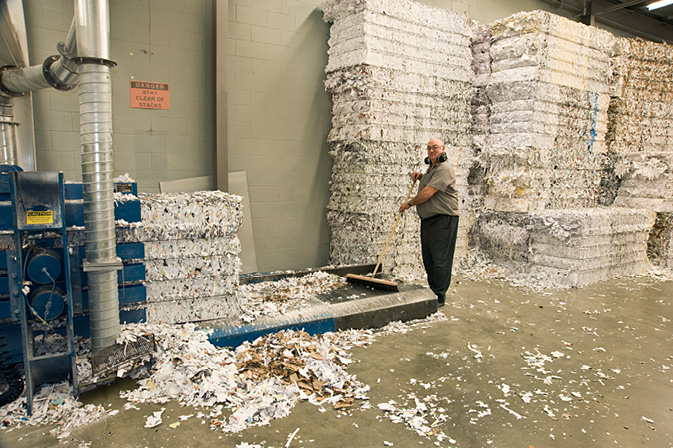
Fig. 22.7 Ron Hildebrand sweeping shredded paper fragments into a ‘compactor’ to produce ‘paper bales’. Friesens Corporation, Altona, Manitoba, Canada, 2011 (photo by Rosemarie and Pat Keough; reprinted with permission from Rosemarie and Pat Keough)
One notable example of a large-scale effort to reconstruct a body of knowledge that had been destroyed through shredding is the citizen-led initiative to prevent the complete loss of the records of governance under the GDR Ministry for State Security (Stasi) in Germany between 1950 and 1990. In 1989, amid growing social unrest and pressure, the GDR government ordered employees in its Ministry for State Security to systematically destroy all government files through the use of paper shredders. However, the shredders assigned to carry out this colossal task proved inadequate; they were not able to shred quickly enough. As a result, Stasi employees were ordered to supplement the shredders’ destruction with their own manual shredding. In the end, the majority of the 600 million paper fragments produced by the Stasi document annihilation project were shredded by hand (Menzel 2014). When the public became aware of the Stasi’s attempt to destroy this evidence, German citizens stepped in and prevented the total destruction of this archive by occupying Stasi offices and demanding a halt to the shredding. The citizens’ group seized 16,250 large bags of paper fragments that the Stasi had planned to reduce to paper pulp, or to burn, following which any attempt to reconstruct these documents would have been impossible (Spiegel 2007; unnamed author). This seizure prompted the reunified German state to fund a long-term project dedicated to the reconstruction of destroyed Stasi documents. However, due to the sheer scale of the project, it was soon decided that manual reconstruction techniques would need to be replaced by a technological solution that would speed up the process of reconstructing destroyed evidence. It has been estimated that if human hands were to proceed alone with the reconstruction project, the task of rendering the fragments into coherent and readable documents would take between 600 and 800 years (Spiegel 2007).
The German federal government has dedicated more than 30 million Euros to the development of a technology that would carry out the reconstruction of these paper fragments without the need for human intervention in the process of document analysis. Researchers at the Fraunhofer Institute for Production Systems and Design Technology in Berlin have been working to develop a machine for the automated analysis of annihilated documents, dubbed the ‘Stasi-Schnipselmaschine’ (the Stasi Snippet Machine), since 2000 (Nikolay and Schneider 2007). The ‘Stasi-Schnipselmaschine’ consists of a computer program that uses algorithms to recognise and sort the paper fragments through the use of scanners, thereby reuniting fragments with like fragments that had originally produced meaning together within the form of a single page (Nickolay and Schneider 2007). The program is designed to recognise and reconstruct shredded fragments (see Figure 22.8) and manually-torn fragments (see Figure 22.9). While the reconstruction project remains incomplete, the development of this reconstruction technology will likely soon be exported for use by other national reconstruction projects, including those taking place in the Czech Republic, Poland, Chile, Argentina, and Guatemala (Menzel 2014). The relative success of the government initiative to restore shredded documents points to the incomplete and reversible nature of the destruction carried out by paper shredders.
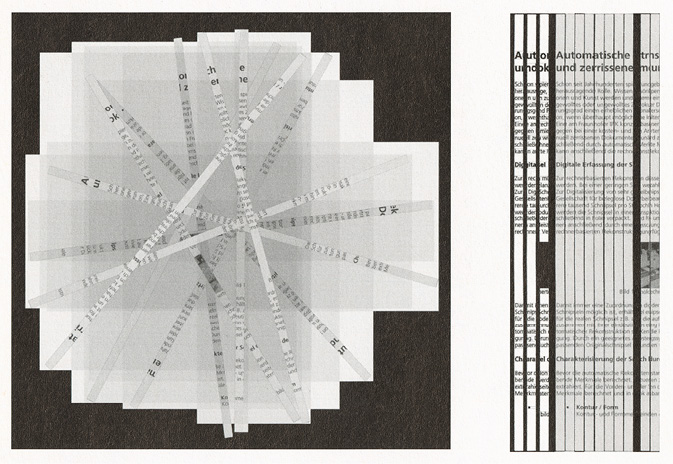
Fig. 22.8 Shredded paper fragments in the process of being reconstructed by the ‘Stasi-Schnipselmaschine’ (image reprinted from Nicoklay and Scheider 2007: 26)
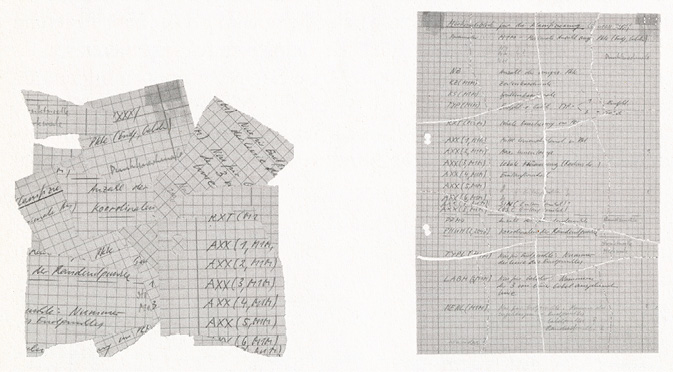
Fig. 22.9 Larger, hand-torn paper fragments in the process of being reconstructed by the ‘Stasi-Schnipselmaschine’ (image reprinted from Nickolay and Schneider 2007: 22)
The stakes of the success of shredding are high; destruction must be total. For this reason, the frequency with which shredders become ‘jammed’, and the flow-through of paper materials suddenly halted, presents a significant problem for those who aspire to limit access to and traceability of a body of knowledge through shredding. To make matters worse, the shredder’s ‘reverse’ button doesn’t always solve the problem, by undoing the ‘jam’ and allowing the destruction to proceed as desired. The shredder doesn’t always heed the call of ‘reverse’; instead, the ‘paper jam’ speaks the shredder’s desire to leave some instances of destruction incomplete. Perhaps both Low and Ehinger anticipated the need to undo processes of knowledge de-formation, leading to the design of a technology that would preserve at least partially legible traces as openings for reconstruction.
Notes
1 It is important to note here that the destruction of knowledge through the technology of paper shredding stands as just one example of the many practices and processes of erasure that render the archive a site more accurately characterised by its exclusions and its absences than by that which it manages to protect.
2 Prior to the digital era, printed papers enjoyed a special status as a form of circulable – and thus both particularly valuable and particularly dangerous – knowledge. Paper was understood as a medium for the stabilisation of knowledge; the particular form of inscriptions on paper loaned a quality of robust evidenceness to a set of ideas inscribed on a document. Paper technology could, temporarily at least, and with great consequence, bring any particular form of knowledge – though always in flux – to a halt. It is in this form of temporal stasis that the paper document does its work as a form of evidence. And it was for this reason that a method by which it would be possible to destroy the document-as-proof was so urgently needed.
References
Bowker, G. C., Memory Practices in the Sciences (Cambridge, MA: MIT Press, 2005).
Ehinger, A., ‘Shredder for documents and the like’, patent application filed at the United States Patent Office on 26 October 1970, US patent number 84061.
Keough, R., and P. Keough, ‘Destroyed Materials for Recycling’, 27 January 2011, <http://www.keough-art.com/tome_passion_blog/tome_passion_blog_4.php> [accessed 29 October 2018].
Low, A. A., ‘Waste-paper receptacle’, patent application filed at the United States Patent Office on 2 February 1909, US patent number 929960.
Menzel, B., ‘Das fetzt.’, Zeit Online, 27 November 2014, <http://www.zeit.de/2014/49/geschredderte-stasi-akten-maschine/komplettansicht> [accessed 29 October 2018].
Nickolay, B., and J. Schneider, ‘Automatische virtuelle Rekonstruktion “vorvernichteter” Stasi-Unterlagen: Machbarkeit, Systemlösung, Potenziale’, in J. Weberling and G. Spitzer, eds, Virtuelle Rekonstruktion “vorvernichteter” Stasi-Unterlagen: Technologische Machbarkeit und Finanzierbarkeit – Folgerungen für Wissenschaft, Kriminaltechnik und Publizistik (Berlin: Berliner Landesbeauftragten für die Unterlagen des Staatssicherheitsdienstes der ehemaligen DDR, 2007), pp. 11–28.
Woestendiek, J., ‘The Compleat History of Shredding’, The Baltimore Sun, 10 February 2002, <http://articles.baltimoresun.com/2002–02–10/entertainment/0202110302_1_paper-shredders-papyrus-thereof> [accessed 29 October 2018].
[Unnamed author], ‘Geschredderte Akten: Computer puzzelt Stasi-Schnipsel zusammen’, Spiegel Online, 9 May 2007, <http://www.spiegel.de/wissenschaft/mensch/geschredderte-akten-computer-puzzelt-stasi-schnipsel-zusammen-a-481984.html> [accessed 29 October 2018].
